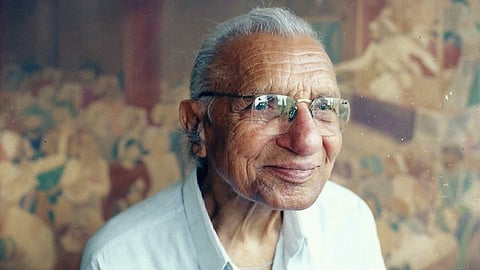

After three decades of silence, the works of art pioneer Professor Sukhvir Sanghal’s has graced the walls of Delhi’s IIC Annexe. A master of wash painting technique and a key figure of the Bengal School of Art, Sanghal's brush captured everything from the spirit of mythological icons like Rama and Arjuna to the silent lives of everyday people. Titled ‘The Silent Canvas Speaks Again’, Chandra envisions it as a tribute to her grandfather’s “timeless vision”.
“I wanted the exhibition to reflect the diversity of mediums and techniques he explored throughout his artistic journey,” she says. She grew up watching her grandfather paint, and was introduced to art through his guidance. “I’d say my eyes opened to the world through his paintings,” she recalls. “I learned the delicate wash technique directly from him as a child, and under his guidance, created several works of my own.”
Though Chandra pursued computer science — completing her Master’s in the USA, and working there — she eventually returned to India to reconnect with her grandfather’s legacy. “I left my job and came back to India to dedicate myself to preserving and promoting his art,” she says.
Sanghal’s brushstrokes
On view are some of Sanghal’s wash paintings, alongside his watercolour works on wood and silk. The show features several of his defining series, including ‘Ramcharit’—lyrical portrayals of Lord Rama that narrate episodes from the Ramayana—as well as ‘River of Life’, ‘Marriage’, ‘Arjuna as the Ideal Man’, ‘Indian Life’, and finally, ‘Kashmir Landscape’. The curation reflects Chandra’s intent to evoke specific rasas (emotional essences) through these five key series.
Sanghal was a keen observer of life, yet much of his work stemmed from a vivid imagination. In the ‘Marriage’ series, he depicts Indian culture, tradition, and human psychology through various stages of marriage. “This series is a rich interplay of Sṛingāra Rasa (the aesthetic of love and beauty) and Karuṇā Rasa (the emotion of compassion and pathos), capturing the emotional spectrum of one of life’s most significant transitions,” says Chandra.
One of the most captivating works in this series is the 1975 painting ‘Marriage Procession’, in which Sanghal renders a bustling wedding scene in exquisite detail: a girl gazing at the groom, the groom astride a horse, and family members watching from balconies, gently tugging their children to stay quiet and still. “‘Marriage Procession’ — the largest painting in the series — features over 250 intricately rendered figures, each one a story unto itself,” notes Chandra.
Another standout in the exhibition is Sanghal’s people-centric work, from the ‘Indian Life’ series, which depicts figures carrying baskets of grain, and spotlights the labour-intensive lives of everyday people. “Prof. Sanghal believed that the hardworking sections of society formed the backbone of the nation—far more representative of the collective human experience than the elite class,” says Chandra.
With the exhibition now underway, Chandra says she hopes to bring more attention to Sanghal’s life and legacy. Plans are already in motion to take the show to other cities and eventually abroad. “He wrote a three-volume book titled Evolution of Art and Artist during his lifetime, which remains unpublished. I plan to publish it soon,” she says. “We also hope to support emerging artists who work with similar depth and integrity.”
On view at Annexe Art Gallery, IIC Annexe, Lodhi Estate, New Delhi, from 11 am to 7 pm, till June 17